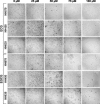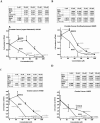Epicatechins Purified from Green Tea (Camellia sinensis) Differentially Suppress Growth of Gender-Dependent Human Cancer Cell Lines
- PMID: 16786054
- PMCID: PMC1475929
- DOI: 10.1093/ecam/nel003
Epicatechins Purified from Green Tea (Camellia sinensis) Differentially Suppress Growth of Gender-Dependent Human Cancer Cell Lines
Abstract
The anticancer potential of catechins derived from green tea is not well understood, in part because catechin-related growth suppression and/or apoptosis appears to vary with the type and stage of malignancy as well as with the type of catechin. This in vitro study examined the biological effects of epicatechin (EC), epigallocatechin (EGC), EC 3-gallate (ECG) and EGC 3-gallate (EGCG) in cell lines from human gender-specific cancers. Cell lines developed from organ-confined (HH870) and metastatic (DU145) prostate cancer, and from moderately (HH450) and poorly differentiated (HH639) epithelial ovarian cancer were grown with or without EC, EGC, ECG or EGCG. When untreated cells reached confluency, viability and doubling time were measured for treated and untreated cells. Whereas EC treatment reduced proliferation of HH639 cells by 50%, EGCG suppressed proliferation of all cell lines by 50%. ECG was even more potent: it inhibited DU145, HH870, HH450 and HH639 cells at concentrations of 24, 27, 29 and 30 microM, whereas EGCG inhibited DU145, HH870, HH450 and HH639 cells at concentrations 89, 45, 62 and 42 microM. When compared with EGCG, ECG more effectively suppresses the growth of prostate cancer and epithelial ovarian cancer cell lines derived from tumors of patients with different stages of disease.
Figures






Similar articles
-
Differential growth suppression of human melanoma cells by tea (Camellia sinensis) epicatechins (ECG, EGC and EGCG).Evid Based Complement Alternat Med. 2009 Dec;6(4):523-30. doi: 10.1093/ecam/nem140. Epub 2007 Oct 22. Evid Based Complement Alternat Med. 2009. PMID: 18955299 Free PMC article.
-
Preparation and antioxidant activity of green tea extract enriched in epigallocatechin (EGC) and epigallocatechin gallate (EGCG).J Agric Food Chem. 2009 Feb 25;57(4):1349-53. doi: 10.1021/jf803143n. J Agric Food Chem. 2009. PMID: 19182914
-
The green tea catechins, (-)-Epigallocatechin-3-gallate (EGCG) and (-)-Epicatechin-3-gallate (ECG), inhibit HGF/Met signaling in immortalized and tumorigenic breast epithelial cells.Oncogene. 2006 Mar 23;25(13):1922-30. doi: 10.1038/sj.onc.1209227. Oncogene. 2006. PMID: 16449979
-
Induction of apoptosis by green tea catechins in human prostate cancer DU145 cells.Life Sci. 2001 Jan 26;68(10):1207-14. doi: 10.1016/s0024-3205(00)01020-1. Life Sci. 2001. PMID: 11228105
-
Blood brain barrier permeability of (-)-epigallocatechin gallate, its proliferation-enhancing activity of human neuroblastoma SH-SY5Y cells, and its preventive effect on age-related cognitive dysfunction in mice.Biochem Biophys Rep. 2017 Jan 5;9:180-186. doi: 10.1016/j.bbrep.2016.12.012. eCollection 2017 Mar. Biochem Biophys Rep. 2017. PMID: 28956003 Free PMC article.
Cited by
-
The Potential Roles of Epigallocatechin-3-Gallate in the Treatment of Ovarian Cancer: Current State of Knowledge.Drug Des Devel Ther. 2020 Oct 12;14:4245-4250. doi: 10.2147/DDDT.S253092. eCollection 2020. Drug Des Devel Ther. 2020. PMID: 33116412 Free PMC article. Review.
-
Effects of green tea catechins on gramicidin channel function and inferred changes in bilayer properties.FEBS Lett. 2011 Oct 3;585(19):3101-5. doi: 10.1016/j.febslet.2011.08.040. Epub 2011 Sep 1. FEBS Lett. 2011. PMID: 21896274 Free PMC article.
-
A screening of growth inhibitory activity of Iranian medicinal plants on prostate cancer cell lines.Biomedicine (Taipei). 2018 Jun;8(2):8. doi: 10.1051/bmdcn/2018080208. Epub 2018 May 28. Biomedicine (Taipei). 2018. PMID: 29806586 Free PMC article.
-
Preparation of catechin extracts and nanoemulsions from green tea leaf waste and their inhibition effect on prostate cancer cell PC-3.Int J Nanomedicine. 2016 May 6;11:1907-26. doi: 10.2147/IJN.S103759. eCollection 2016. Int J Nanomedicine. 2016. PMID: 27226712 Free PMC article.
-
Pterostilbene-isothiocyanate reduces miR-21 level by impeding Dicer-mediated processing of pre-miR-21 in 5-fluorouracil and tamoxifen-resistant human breast cancer cell lines.3 Biotech. 2023 Jun;13(6):193. doi: 10.1007/s13205-023-03582-3. Epub 2023 May 16. 3 Biotech. 2023. PMID: 37205177 Free PMC article.
References
-
- USDA Database for the Flavonoid Content of Selected Foods, Prepared by the Nutrient Data Laboratory, Food Composition Laboratory, Beltsville Human Nutrition Research Center, Agricultural Research Service, US Department of Agriculture, Belsville, MD, 2003.
-
- Chen C, Yu R, Owuor ED, Kong AN. Activation of antioxidant-response element (ARE), mitogen-activated protein kinases (MAPKs), caspases by major green tea polyphenol components during cell survival and death. Arch Pharm Res. 2000;23:605–12. - PubMed
-
- Chung LY, Cheung TC, Kong SK, Fung KP, Choy YM, Chan ZY, et al. Induction of apoptosis by green tea catechins in human prostate cancer DU145 cells. Life Sci. 2001;68:1207–14. - PubMed
-
- Tan X, Hu D, Li S, Han Y, Zhang Y, Zhou D. Differences of four catechins in cell cycle arrest and induction of apoptosis in LoVo cells. Cancer Lett. 2000;158:1–6. - PubMed
Grants and funding
LinkOut - more resources
Full Text Sources
Other Literature Sources

